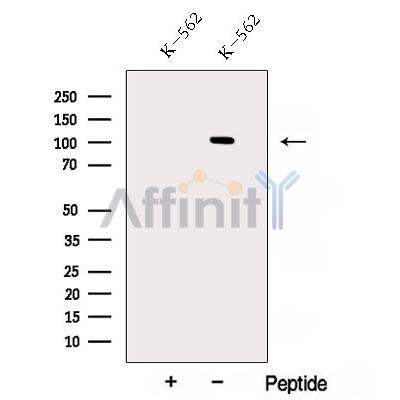AP2B1 Antibody - #DF12824
| Product: | AP2B1 Antibody |
| Catalog: | DF12824 |
| Description: | Rabbit polyclonal antibody to AP2B1 |
| Application: | WB IHC |
| Reactivity: | Human, Mouse, Rat |
| Prediction: | Pig, Zebrafish, Bovine, Horse, Sheep, Rabbit, Dog, Chicken, Xenopus |
| Mol.Wt.: | 105 kDa; 105kD(Calculated). |
| Uniprot: | P63010 |
| RRID: | AB_2845785 |
Related Downloads
Protocols
Product Info
*The optimal dilutions should be determined by the end user. For optimal experimental results, antibody reuse is not recommended.
*Tips:
WB: For western blot detection of denatured protein samples. IHC: For immunohistochemical detection of paraffin sections (IHC-p) or frozen sections (IHC-f) of tissue samples. IF/ICC: For immunofluorescence detection of cell samples. ELISA(peptide): For ELISA detection of antigenic peptide.
Cite Format: Affinity Biosciences Cat# DF12824, RRID:AB_2845785.
Fold/Unfold
Adapter related protein complex 2 beta 1 subunit; Adapter-related protein complex 2 beta subunit; Adaptin, beta 2 (beta); Adaptor protein complex AP-2 subunit beta; Adaptor related protein complex 2, beta 1 subunit; ADTB2; AP-2 complex subunit beta; AP105B; AP2 BETA; Ap2b1; AP2B1_HUMAN; Beta adaptin; Beta-2-adaptin; Beta-adaptin; Beta2 adaptin; CLAPB1; Clathrin assembly protein complex 2 beta large chain; Clathrin associated/assembly/adaptor protein, large, beta 1; DKFZp781K0743; Plasma membrane adaptor HA2/AP2 adaptin beta subunit;
Immunogens
A synthesized peptide derived from human AP2B1, corresponding to a region within N-terminal amino acids.
- P63010 AP2B1_HUMAN:
- Protein BLAST With
- NCBI/
- ExPASy/
- Uniprot
MTDSKYFTTNKKGEIFELKAELNNEKKEKRKEAVKKVIAAMTVGKDVSSLFPDVVNCMQTDNLELKKLVYLYLMNYAKSQPDMAIMAVNSFVKDCEDPNPLIRALAVRTMGCIRVDKITEYLCEPLRKCLKDEDPYVRKTAAVCVAKLHDINAQMVEDQGFLDSLRDLIADSNPMVVANAVAALSEISESHPNSNLLDLNPQNINKLLTALNECTEWGQIFILDCLSNYNPKDDREAQSICERVTPRLSHANSAVVLSAVKVLMKFLELLPKDSDYYNMLLKKLAPPLVTLLSGEPEVQYVALRNINLIVQKRPEILKQEIKVFFVKYNDPIYVKLEKLDIMIRLASQANIAQVLAELKEYATEVDVDFVRKAVRAIGRCAIKVEQSAERCVSTLLDLIQTKVNYVVQEAIVVIRDIFRKYPNKYESIIATLCENLDSLDEPDARAAMIWIVGEYAERIDNADELLESFLEGFHDESTQVQLTLLTAIVKLFLKKPSETQELVQQVLSLATQDSDNPDLRDRGYIYWRLLSTDPVTAKEVVLSEKPLISEETDLIEPTLLDELICHIGSLASVYHKPPNAFVEGSHGIHRKHLPIHHGSTDAGDSPVGTTTATNLEQPQVIPSQGDLLGDLLNLDLGPPVNVPQVSSMQMGAVDLLGGGLDSLVGQSFIPSSVPATFAPSPTPAVVSSGLNDLFELSTGIGMAPGGYVAPKAVWLPAVKAKGLEISGTFTHRQGHIYMEMNFTNKALQHMTDFAIQFNKNSFGVIPSTPLAIHTPLMPNQSIDVSLPLNTLGPVMKMEPLNNLQVAVKNNIDVFYFSCLIPLNVLFVEDGKMERQVFLATWKDIPNENELQFQIKECHLNADTVSSKLQNNNVYTIAKRNVEGQDMLYQSLKLTNGIWILAELRIQPGNPNYTLSLKCRAPEVSQYIYQVYDSILKN
Predictions
Score>80(red) has high confidence and is suggested to be used for WB detection. *The prediction model is mainly based on the alignment of immunogen sequences, the results are for reference only, not as the basis of quality assurance.
High(score>80) Medium(80>score>50) Low(score<50) No confidence
Research Backgrounds
Component of the adaptor protein complex 2 (AP-2). Adaptor protein complexes function in protein transport via transport vesicles in different membrane traffic pathways. Adaptor protein complexes are vesicle coat components and appear to be involved in cargo selection and vesicle formation. AP-2 is involved in clathrin-dependent endocytosis in which cargo proteins are incorporated into vesicles surrounded by clathrin (clathrin-coated vesicles, CCVs) which are destined for fusion with the early endosome. The clathrin lattice serves as a mechanical scaffold but is itself unable to bind directly to membrane components. Clathrin-associated adaptor protein (AP) complexes which can bind directly to both the clathrin lattice and to the lipid and protein components of membranes are considered to be the major clathrin adaptors contributing the CCV formation. AP-2 also serves as a cargo receptor to selectively sort the membrane proteins involved in receptor-mediated endocytosis. AP-2 seems to play a role in the recycling of synaptic vesicle membranes from the presynaptic surface. AP-2 recognizes Y-X-X-[FILMV] (Y-X-X-Phi) and [ED]-X-X-X-L-[LI] endocytosis signal motifs within the cytosolic tails of transmembrane cargo molecules. AP-2 may also play a role in maintaining normal post-endocytic trafficking through the ARF6-regulated, non-clathrin pathway. During long-term potentiation in hippocampal neurons, AP-2 is responsible for the endocytosis of ADAM10. The AP-2 beta subunit acts via its C-terminal appendage domain as a scaffolding platform for endocytic accessory proteins; at least some clathrin-associated sorting proteins (CLASPs) are recognized by their [DE]-X(1,2)-F-X-X-[FL]-X-X-X-R motif. The AP-2 beta subunit binds to clathrin heavy chain, promoting clathrin lattice assembly; clathrin displaces at least some CLASPs from AP2B1 which probably then can be positioned for further coat assembly.
Phosphorylation at Tyr-737 by SRC occurs at the plasma membrane in clathrin-coated vesicles (CCVs).
Cell membrane. Membrane>Coated pit>Peripheral membrane protein>Cytoplasmic side.
Note: AP-2 appears to be excluded from internalizing CCVs and to disengage from sites of endocytosis seconds before internalization of the nascent CCV.
Expressed in the brain (at protein level).
Belongs to the adaptor complexes large subunit family.
Research Fields
· Cellular Processes > Transport and catabolism > Endocytosis. (View pathway)
· Human Diseases > Neurodegenerative diseases > Huntington's disease.
· Organismal Systems > Nervous system > Synaptic vesicle cycle.
· Organismal Systems > Excretory system > Endocrine and other factor-regulated calcium reabsorption.
Restrictive clause
Affinity Biosciences tests all products strictly. Citations are provided as a resource for additional applications that have not been validated by Affinity Biosciences. Please choose the appropriate format for each application and consult Materials and Methods sections for additional details about the use of any product in these publications.
For Research Use Only.
Not for use in diagnostic or therapeutic procedures. Not for resale. Not for distribution without written consent. Affinity Biosciences will not be held responsible for patent infringement or other violations that may occur with the use of our products. Affinity Biosciences, Affinity Biosciences Logo and all other trademarks are the property of Affinity Biosciences LTD.


